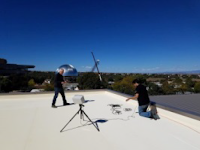Week 10: Drone Net Updates and Future Goals

Hello Everyone! During this week, the Professor and I modified the Drone Net and set it up to acquire data with its new design. What modifications has Drone Net incurred over since February? The initial design of drone net includes a basic weatherproof, outdoor electrical box. The box is mounted on a regular camera tripod. Inside the box, three cameras are mounted with the color cameras arranged like a pair of eyes and infrared camera in the middle. This design features the classic stereo camera "eyes." The new design condenses the cameras down to one color and one infrared. The cameras are mounted at the same height and close together. This modification was chosen because closer cameras allow for quicker software processing time and easier calibration of the cameras. We also drilled holes in the electrical box to keep the Drone Net more weatherproof, allowing it to be left outside for extended periods of time. This design puts the two cameras closer together....




